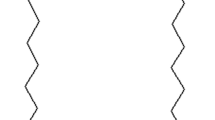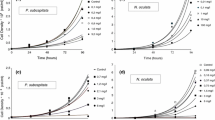Abstract
The toxic effect of triethyl lead (TriEL) on the phytoflagellatePoterioochromonas malhamensis (Chrysophyceae) was compared with those of eight surfactants some of which represent environmental pollutants. The surfactants typically inhibited algal growth and caused cytolysis in the concentration range from 12 to 310 μM. TriEL was cytolytic, similar to the surfactants, while lethal concentrations of inorganic lead did not cause cytolysis. The cationic and zwitterionic surfactants and SDS 1 and TriEL selectively inhibited mitosis and cytokinesis of the alga and caused the formation of giant multinucleated cells, suggesting selective interaction on the algal microtubules (MTs). However, DOC, TX100, and TX405 had no selective effects on these parameters. The most active surfactant, SDS, inhibited MT assemblyin vitro and caused an instant and complete disassembly if applied to MTs that were preassembled without surfactant. TX100, which was inactive in the algae, showed no effect in thein vitro MT assay, even if applied in ten times higher concentrations than SDS.
The observations indicate that the surfactants did not act chaotropically on the alga's cell membranes. It is postulated that the cytolytic effect of the surfactants (and of TriEL) was mainly governed by combined hydrophobic and electrostatic interactions with the lipid phase of the membranes, with cationic surfactants being much more effective than others. The selective action of some of the surfactants (like that of TriEL) was presumably caused by a selective interaction with protein structures. As the active surfactants were all applied in concentrations below their respective critical micelle concentrations, gross solubilization or denaturation of membrane and other proteins was most likely not involved in the observed selective effects. The results suggest that not only TriEL, but also the active surfactants (besides possible interference with cell membranes) selectively interferred with MTs and that this was the primary mechanism of their selective toxic action inP. malhamensis.
Similar content being viewed by others
References
Abramson JJ, Shamoo AE (1979) Anionic detergents as divalent cation ionophores across black lipid membranes. J Membrane Biol 50:241–255
Bangham JA, Lea EJA (1978) The interaction of detergents with bilayer lipid membranes. Biochim Biophys Acta 511:388–396
Bjerrum PJ (1984) Induction of anion transfer in biological membranes. In: Grandjean P (ed) Biological Effects of Organo-Lead Compounds. CRC Press, Boca Raton, Florida p 125
Brewer JE, Bell LGE (1969) Reaction of detergents withAmoeba proteus. Nature 222:891–892
Cremer JE, Callaway S (1961) Further studies on the toxicity of some tetra and trialkyl lead components. Brit J Industr Med 18:277–282
DiStasio JI (ed) (1981) Surfactants, Detergents and Sequestrants. Developments since 1979. Noyes Data Corporation, Park Ridge, New Jersey.
Doenges KH, Biedert S, Paweletz N (1976) Characterization of a 20S component in tubulin from mammalian brain. Biochemistry 15:2995–2999
Ernst R, Arditti J (1984) Biological effects of surfactants VII. Growth and development ofBrassocatleya (Orchidaceae) seedlings. New Phytol 96:197–205
Gonenne A, Ernst R (1978) Solubilization of membrane proteins by sulfobetaines, novel zwitterionic surfactants. Anal Biochem 87:28–38
Haeffner EW, Zimmermann HP, Hoffmann CJK (1984) Influence of triethyl lead on the activity of enzymes of the ascites tumor cell plasma membrane and its microviscosity. Toxicol Lett 23:183–188
Healey PL, Ernst R, Arditti J (1971) Biological effects of surfactants II. Influence on the ultrastructure of orchid seedlings. New Phytol 70:477–482
Helenius A, Simons K (1975) Solubilization of membranes by detergents. Biochim Biophys Acta 415:29–79
Helenius A, McCashin DR, Fries E, Tanford C (1979) Properties of detergents. In: Methods in Enzymology. Vol. LVI, Part G, Academic Press, New York, p 734
Hjelmeland LM (1980) A nondenaturing zwitterionic detergent for membrane biochemistry: design and synthesis. Proc Natl Acad Sci USA 77:6368–6370
Hrabak A, Antoni F, Szabo MT (1982) Damaging effect of detergents on human lymphocytes. Bull Environ Contam Toxicol 28:504–511
Isomaa B, Mergman H, Sandberg P (1979) The binding of CTAB, a cationic surfactant, to the rat erythrocyte membrane. Acta Pharmacol Toxicol 44:36–42
Kaars Sjpesterjn A, Rijkens F, Luijen JGA, Willemsen LC (1962) On the antifungal and antibacterial activity of some trisubstituted organogermanium, organotin, and organolead compounds. J Microbiol Serol 28:346–356.
Maenz DD, Forsyth GW (1982) Ricinoleate and deoxycholate are calcium ionophores in jejunum brush border vesicles. J Membrane Biol 70:125–133
Makino S, Reynolds JA, Tanford C (1973) The binding of deoxycholate and Triton X-100 to proteins. J Biol Chem 248:4926–4932
Nielsen T (1984) Atmospheric occurrence of organolead compounds. In: Grandjean P (ed) Biological Effects of Organo-Lead Compounds. CRC Press, Boca Raton, Florida, p 43
Nozaki Y, Reynolds JA, Tanford C (1974) Interaction of cationic detergent with bovine serum albumin and other proteins. J Biol Chem 249:4452–4459
Pethica BA, Schulman JH (1953) The physical chemistry of haemolysis by surface-active agents. Biochem 53:177–185
Reynolds JA, Herbert S, Polet H, Steinhardt J (1967) The binding of diverse detergent anions to bovine serum albumin. Biochemistry 6:937–947
Reynolds JA, Tanford C (1970) Binding of dodecyl sulfate to protein at high binding ratios. Possible implications for the state of proteins in biological membranes. Proc Natl Acad Sci USA 66:1002–1007
Riedel B, Christensen G (1979) Effect of selected water toxicants and other chemicals upon adenosine triphosphatase activity. Bull Environ Contam Toxicol 23:365–368
Rifkin RJ (1965)In vitro inhibition of Na+-Na+ and Mg2+ ATPases by mono-, di-, and trivalent cations. Proc Soc Exp Biol Med 120:802–804
Röderer G (1980) On the toxic effects of tetraethyl lead and its derivatives on the chrysophytePoterioochromonas malhamensis. I. Tetraethyl lead. Environ Res 23:371–384
— (1981) On the toxic effects of tetraethyl lead and its derivatives on the chrysophytePoterioochromonas malhamensis. II. Triethyl lead, diethyl lead, and inorganic lead. Environ Res 25:361–371
— (1982a) On the toxic effects of tetraethyl lead and its derivatives on the chrysophytePoterioochromonas malhamensis. III. Chemical analyses. J Environ Sci Health A17:1–20
— (1982b) Biological effects of inorganic and organic compounds of mercury, lead, tin, and arsenic. In: Hemphill DD (ed) Trace Substances in Environmental Health—XVI. University of Missouri, Columbia, p 137
— (1984a) Selective interaction of triethyl lead with microtubules from mammalian and nonmammalian cells. In: Hemphill DD (ed) Trace Substances in Environmental Health—XVIII. University of Missouri, Columbia, p 514
— (1984b) Toxic effects in plant organisms. In: Grandjean P (ed) Biological Effects of Organo-Lead Compounds. CRC Press, Boca Raton, Florida, p 63
— (1986a) On the toxic effects of tetraethyl lead and its derivatives on the chrysophytePoterioochromonas malhamensis. VI. Effects on lorica formation, mitosis and cytokinesis. Environ Res 39:205–231
— (1986b) On the toxic effects of tetraethyl lead and its derivatives on the chrysophytePoterioochromonas malhamensis. VII. Protective action of thiol compounds, vitamins, trace elements, and other agents. Ecotoxicol Environ Safety 11:277–294
Röderer G, Doenges KH (1983) Influence of trimethyl lead and inorganic lead on thein vitro assembly of microtubules from mammalian brain. Neurotoxicity 4:171–180
Schnepf E, Deichgräber G, Röderer G, Herth W (1977) The flagellar root apparatus, the microtubular system and associated organelles in the chrysophycean flagellate,Poterioochromonas malhamensis Peterfi (syn.Poteriochromonas stipitata Scherffel andOchromonas malhamensis Pringsheim). Protoplasma 92:87–107.
Steck TL, Fox CF (1972) Membrane proteins. In: Fox CF, Keith Ad (eds) Membrane Molecular Biology. Sinauer Associates Inc, Stanford, Connecticut, p 40
White GF, Russell NJ, Day MJ (1985) A survey of sodium dodecylsulfate (SDS) resistance and alkylsulphatase production in bacteria from clean and polluted river sites. Environ Pollut Ser A 37:1–11
Zimmermann HP, Doenges KH, Röderer G (1985) Interaction of triethyl lead chloride with microtubulesin vitro and in mammalian cells. Exp Cell Res 156:140–152.
Author information
Authors and Affiliations
Rights and permissions
About this article
Cite this article
Röderer, G. Toxic effects of tetraethyl lead and its derivatives on the chrysophytePoterioochromonas malhamensis. VIII. Comparative studies with surfactants. Arch. Environ. Contam. Toxicol. 16, 291–301 (1987). https://doi.org/10.1007/BF01054946
Received:
Revised:
Issue Date:
DOI: https://doi.org/10.1007/BF01054946




